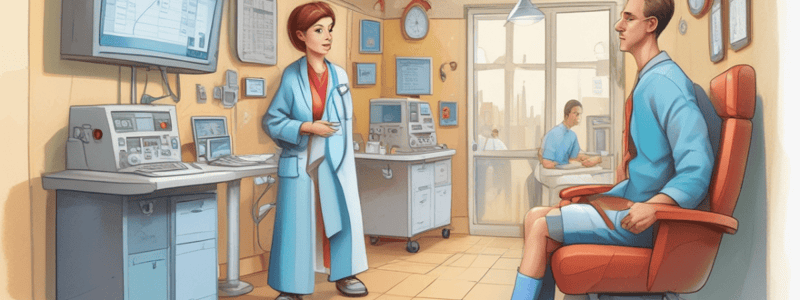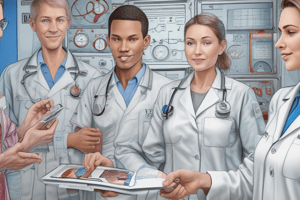Podcast
Questions and Answers
What is the primary consequence of cellular malnourishment in insulin deficiency?
What is the primary consequence of cellular malnourishment in insulin deficiency?
- Polyphagia (correct)
- Weight loss and fatigue
- Prolonged wound healing
- Polydipsia and polyuria
Which of the following is a characteristic of diabetic ketoacidosis?
Which of the following is a characteristic of diabetic ketoacidosis?
- Hyperglycemia and hypoglycemia
- Hyperglycemia, acidosis, and dehydration (correct)
- Hypoglycemia and acidosis
- Hypoglycemia and ketosis
What is the primary difference between hyperglycemia and hypoglycemia?
What is the primary difference between hyperglycemia and hypoglycemia?
- Effect on urination
- Presence of ketosis
- Level of glucose in the blood (correct)
- Effect on appetite
What is a common precipitating factor for diabetic ketoacidosis?
What is a common precipitating factor for diabetic ketoacidosis?
What is a manifestation of type 2 DM?
What is a manifestation of type 2 DM?
What is the term for a serious threat that occurs when action is not taken immediately to address hypoglycemia?
What is the term for a serious threat that occurs when action is not taken immediately to address hypoglycemia?
What is the primary goal of giving a patient 15g of a simple carbohydrate during a hypoglycemic episode?
What is the primary goal of giving a patient 15g of a simple carbohydrate during a hypoglycemic episode?
When should a patient ingest a complex carbohydrate after a hypoglycemic episode?
When should a patient ingest a complex carbohydrate after a hypoglycemic episode?
What is the recommended action if a patient's blood glucose level is still below 70mg/dL after 2 or 3 doses of 15g of simple carbohydrate?
What is the recommended action if a patient's blood glucose level is still below 70mg/dL after 2 or 3 doses of 15g of simple carbohydrate?
What is the recommended frequency for checking glucose levels during a hypoglycemic episode?
What is the recommended frequency for checking glucose levels during a hypoglycemic episode?
What is the purpose of checking urine for ketones during a hypoglycemic episode?
What is the purpose of checking urine for ketones during a hypoglycemic episode?
What is the recommended treatment for an unconscious patient with severe hypoglycemia?
What is the recommended treatment for an unconscious patient with severe hypoglycemia?
What is a potential consequence of Poor absorption of insulin?
What is a potential consequence of Poor absorption of insulin?
Which of the following can trigger a rapid onset of high blood glucose levels?
Which of the following can trigger a rapid onset of high blood glucose levels?
What is a potential symptom of high blood glucose levels that can affect daily activities?
What is a potential symptom of high blood glucose levels that can affect daily activities?
Which of the following can cause a gradual onset of high blood glucose levels?
Which of the following can cause a gradual onset of high blood glucose levels?
What is a potential consequence of Too much DM medication?
What is a potential consequence of Too much DM medication?
Which of the following can mask the symptoms of high blood glucose levels?
Which of the following can mask the symptoms of high blood glucose levels?
What is the primary reason for the body to break down fat into ketones in diabetic ketoacidosis?
What is the primary reason for the body to break down fat into ketones in diabetic ketoacidosis?
Which of the following is a likely consequence of untreated diabetic ketoacidosis?
Which of the following is a likely consequence of untreated diabetic ketoacidosis?
What is the relationship between type 1 diabetes and diabetic ketoacidosis?
What is the relationship between type 1 diabetes and diabetic ketoacidosis?
What is the primary function of recognizing symptoms and treating them immediately in diabetic patients?
What is the primary function of recognizing symptoms and treating them immediately in diabetic patients?
Which of the following is a manifestation of diabetic ketoacidosis?
Which of the following is a manifestation of diabetic ketoacidosis?
What is the role of insulin in preventing diabetic ketoacidosis?
What is the role of insulin in preventing diabetic ketoacidosis?
What is the minimum blood glucose level that indicates a laboratory finding of diabetic ketoacidosis?
What is the minimum blood glucose level that indicates a laboratory finding of diabetic ketoacidosis?
What is the significance of arterial blood pH in diagnosing diabetic ketoacidosis?
What is the significance of arterial blood pH in diagnosing diabetic ketoacidosis?
What is the primary consequence of uncontrolled blood glucose levels in diabetic ketoacidosis?
What is the primary consequence of uncontrolled blood glucose levels in diabetic ketoacidosis?
What is the relationship between blood glucose levels and insulin deficiency in diabetic ketoacidosis?
What is the relationship between blood glucose levels and insulin deficiency in diabetic ketoacidosis?
What is the significance of timely intervention in diabetic ketoacidosis?
What is the significance of timely intervention in diabetic ketoacidosis?
What is the underlying.pathophysiology of diabetic ketoacidosis?
What is the underlying.pathophysiology of diabetic ketoacidosis?
Flashcards
Polyphagia in Insulin Deficiency
Polyphagia in Insulin Deficiency
Excessive hunger resulting from cellular malnourishment due to insulin deficiency, as cells can't uptake glucose.
Diabetic Ketoacidosis (DKA)
Diabetic Ketoacidosis (DKA)
A dangerous complication of diabetes characterized by hyperglycemia (high blood sugar), acidosis (blood too acidic), and dehydration.
Hyperglycemia vs. Hypoglycemia
Hyperglycemia vs. Hypoglycemia
Hyperglycemia is high blood glucose. Hypoglycemia is low blood glucose.
Inadequate Insulin Dosage and DKA
Inadequate Insulin Dosage and DKA
Signup and view all the flashcards
Insulin Reaction
Insulin Reaction
Signup and view all the flashcards
Treating Hypoglycemia
Treating Hypoglycemia
Signup and view all the flashcards
Complex Carbs Post-Hypoglycemia
Complex Carbs Post-Hypoglycemia
Signup and view all the flashcards
Persistent Hypoglycemia
Persistent Hypoglycemia
Signup and view all the flashcards
Frequency of Glucose Checks in Hypoglycemia
Frequency of Glucose Checks in Hypoglycemia
Signup and view all the flashcards
Treating Unconscious Hypoglycemia Patient
Treating Unconscious Hypoglycemia Patient
Signup and view all the flashcards
Poor Insulin Absorption
Poor Insulin Absorption
Signup and view all the flashcards
Illness/Infection and Hyperglycemia
Illness/Infection and Hyperglycemia
Signup and view all the flashcards
Unsteady Gait and Hyperglycemia
Unsteady Gait and Hyperglycemia
Signup and view all the flashcards
Fat Breakdown in DKA
Fat Breakdown in DKA
Signup and view all the flashcards
Untreated DKA Consequence
Untreated DKA Consequence
Signup and view all the flashcards
Type 1 Diabetes and DKA
Type 1 Diabetes and DKA
Signup and view all the flashcards
Preventing DKA
Preventing DKA
Signup and view all the flashcards
DKA Manifestations
DKA Manifestations
Signup and view all the flashcards
Insulin's Role in Preventing DKA
Insulin's Role in Preventing DKA
Signup and view all the flashcards
DKA Blood Glucose Level
DKA Blood Glucose Level
Signup and view all the flashcards
Arterial Blood pH in DKA
Arterial Blood pH in DKA
Signup and view all the flashcards
DKA Cellular Malnourishment
DKA Cellular Malnourishment
Signup and view all the flashcards
Insulin Deficiency and Hyperglycemia in DKA
Insulin Deficiency and Hyperglycemia in DKA
Signup and view all the flashcards
Timely Intervention Imperative
Timely Intervention Imperative
Signup and view all the flashcards
Pathophysiology of DKA
Pathophysiology of DKA
Signup and view all the flashcards
Study Notes
Diabetes Melitus
- Polydipsia, polyuria, and polyphagia are consequences of insulin deficiency, which prevents glucose from being used for energy.
- Weight loss, weakness, and fatigue may also occur.
Manifestations of Type 2 Diabetes
- Fatigue, recurrent infections, prolonged wound healing, and vision problems are often nonspecific manifestations of type 2 diabetes.
- Polydipsia, polyuria, and polyphagia may also occur.
Acute Complications of Diabetes
- Acute complications arise from events associated with hyperglycemia and hypoglycemia.
- Hypoglycemia worsens rapidly and constitutes a serious threat if action is not immediately taken.
Hyperglycemia and Hypoglycemia
- Hyperglycemia is characterized by high glucose levels, increased urination, and increased appetite, followed by anorexia, weakness, fatigue, and blurred vision.
- Hypoglycemia is characterized by headache, nausea, vomiting, abdominal cramps, and mood swings.
Diabetic Ketoacidosis (DKA)
- DKA is caused by a profound deficiency of insulin, characterized by hyperglycemia, ketosis, acidosis, and dehydration.
- Precipitating factors include illness, infection, inadequate insulin dosage, undiagnosed type 1 diabetes, lack of education, understanding, or resources, and neglect.
Treatment of Hypoglycemia
- Conscious person: Give 15g of a simple carbohydrate, recheck blood glucose 15 minutes later, and repeat if necessary.
- Unconscious person: Subcutaneous or IM injection of 1mg glucagon, or IV administration of 25-50mL of 50% glucose.
Preventive Measures for Hypoglycemia
- Take prescribed medication as directed.
- Check glucose frequently and check urine for ketones.
- Drink fluids at least hourly.
- Contact HCP about ketonuria.
- Follow the Rule of 15.
- Wear or carry DM identification.
- Teach family and caregiver about symptoms and treatment.
Studying That Suits You
Use AI to generate personalized quizzes and flashcards to suit your learning preferences.



